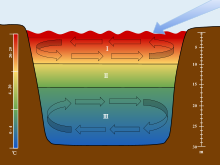User:OHClNaMg/sandbox
Physical Limnology[edit]
Physical limnology is the scientific study of physical processes in inland waters such as lakes, rivers, and streams. Its practitioners are known as physical limnologists. This branch of limnology is most interested in using observations and models of physical properties to describe inland waters, often interfacing with its sister disciplines chemical limnology, geological limnology, and biological limnology. These scientific fields have developed in parallel to similar divisions within oceanography.
Physical Setting[edit]
Inland waters include all non-marine bodies of water on the Earth across the spectra of fresh to saline and natural to man-made. These are generally divided into "lotic" (running waters, e.g. rivers) and "lentic" (still waters, e.g. lakes) systems. Physical limnologists seek to understand this diverse array of aquatic environments by applying physical principles to generate observations and models of physical properties. This research is central to the development of heat budgets, gas exchange studies, wave and seiche height predictions, and pollutant transport models among other applications.
Physical Properties[edit]
Various properties of aquatic environments are used in the study of physical limnology. These include properties of water itself (e.g. temperature) as well as properties of the underwater environment (e.g. light).
Light and Optical Properties[edit]
The light regimes of lakes (and more rarely rivers) are divided into photic (or euphotic) and aphotic zones. The photic zone receives sufficient visible light to support photosynthesis; its depth varies depending on water transmissibility as well as the amount of incident light at the surface. Lying below the photic zone is the aphotic zone, in which photosynthesis does not occur.
Temperature and Heat Exchange[edit]

Heat budgets may be constructed for bodies of water in order to understand the evolution of water temperature, ice coverage, and water levels. Heat fluxes are observed or modeled between air, water, and sediment and integrated to produce an understanding of the thermal environment of aquatic environments.
Density and Salinity[edit]

Water density is the primary factor determining stratification in lakes, which isolates discrete water masses and prevents mixing. Density is a function of temperature, salinity, and pressure, which may change seasonally and lead to the process of overturning (or de-stratification) in holomictic lakes.
